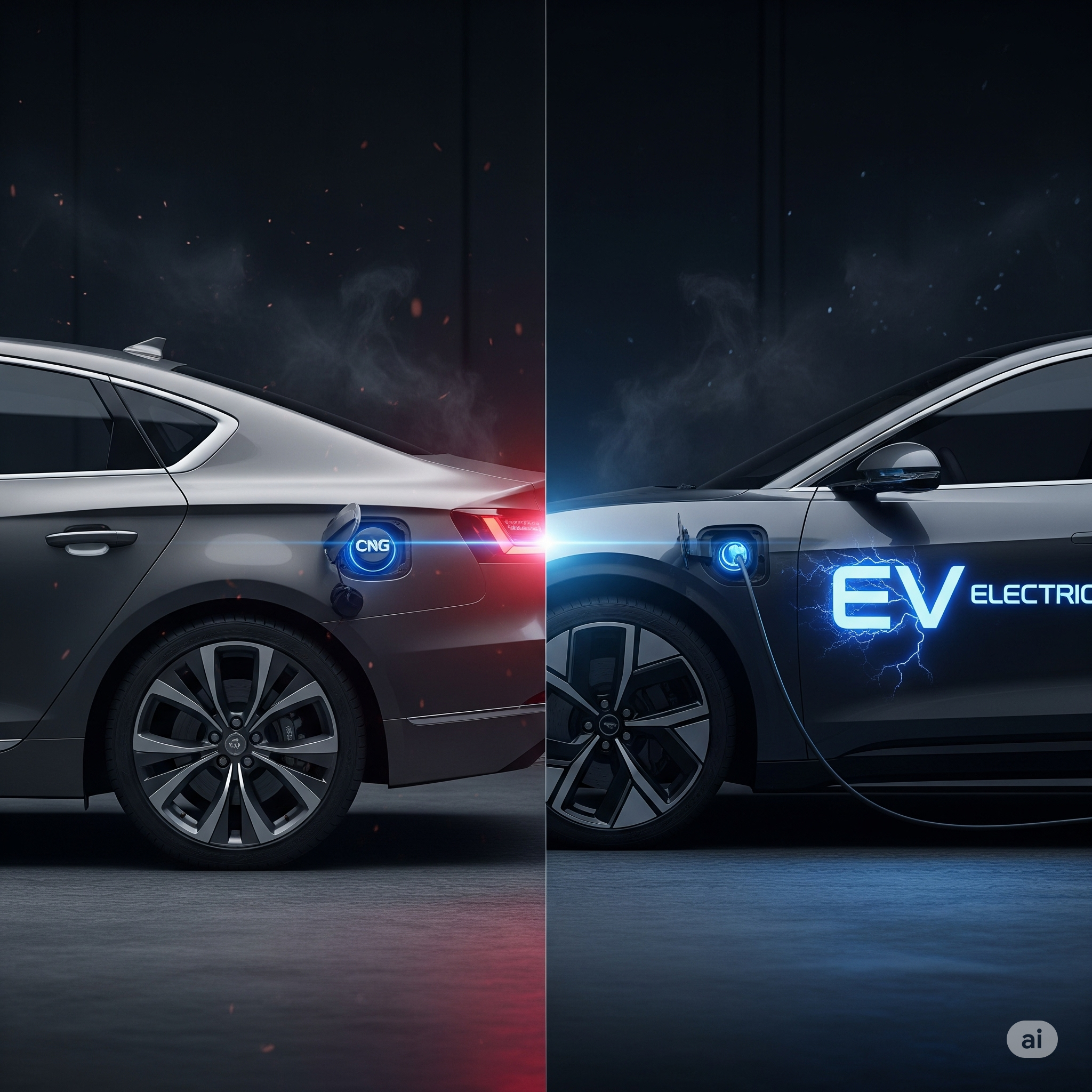Introduction
The automotive industry is at a pivotal crossroads. Rising environmental concerns, fluctuating fuel prices, and technological innovation are reshaping the mobility landscape. Among the key contenders for the future of transportation are Compressed Natural Gas (CNG) vehicles and Electric Vehicles (EVs). Both alternatives offer significant advantages over conventional petrol and diesel vehicles, but they differ in terms of cost, infrastructure requirements, environmental impact, and consumer adoption. This article provides a comprehensive comparison of CNG and electric vehicles, exploring their potential to dominate the future automobile market globally, with a focus on India.
1. Overview of CNG Vehicles
1.1 What is CNG?
Compressed Natural Gas (CNG) is primarily composed of methane, compressed to less than 1% of its original volume. It serves as an alternative fuel for internal combustion engines, offering lower emissions and operational costs compared to petrol and diesel.
1.2 Advantages of CNG Vehicles
- Cost-Effectiveness: CNG is generally cheaper than petrol or diesel, offering significant savings for daily commuters and fleet operators.
- Lower Emissions: CNG vehicles emit up to 30% less carbon dioxide, negligible sulfur, and lower particulate matter, contributing to improved urban air quality.
- Engine Longevity: Cleaner combustion reduces engine wear and maintenance costs.
- Safety: Methane is lighter than air, dispersing quickly in case of leaks, reducing fire hazards.
1.3 Challenges of CNG Vehicles
- Infrastructure Limitations: Refueling stations are concentrated in urban areas; rural and semi-urban adoption is still limited.
- Vehicle Range: CNG vehicles generally offer shorter driving ranges compared to petrol/diesel vehicles.
- Consumer Perception: Some buyers perceive CNG engines as less powerful or suitable only for short distances.
2. Overview of Electric Vehicles (EVs)
2.1 What are EVs?
Electric vehicles use electric motors powered by rechargeable batteries instead of internal combustion engines. EVs can be fully electric (Battery Electric Vehicles – BEVs) or hybrid (Hybrid Electric Vehicles – HEVs and Plug-in Hybrid Electric Vehicles – PHEVs).
2.2 Advantages of EVs
- Zero Tailpipe Emissions: EVs produce no direct emissions, reducing air pollution and greenhouse gases.
- Energy Efficiency: Electric motors convert over 85% of energy into vehicle motion, far higher than internal combustion engines.
- Government Incentives: Subsidies, tax benefits, and lower registration fees encourage adoption in many countries, including India.
- Low Operating Costs: Electricity is generally cheaper than petrol/diesel, and EVs require less frequent maintenance.
2.3 Challenges of EVs
- High Initial Cost: Battery technology increases the upfront cost of EVs compared to conventional and CNG vehicles.
- Charging Infrastructure: Limited charging stations in many regions create range anxiety for consumers.
- Battery Degradation: Batteries lose efficiency over time and require eventual replacement.
- Electric Grid Dependence: Increased EV adoption puts pressure on electricity supply, especially in regions with limited renewable energy.
3. Comparative Analysis: CNG vs EVs
3.1 Environmental Impact
- CNG Vehicles: Lower emissions than petrol/diesel but still produce some CO2 and methane.
- EVs: Zero tailpipe emissions; however, overall environmental benefit depends on electricity generation sources. Renewable energy-powered EVs have a much smaller carbon footprint.
3.2 Cost Considerations
- CNG Vehicles: Lower operational costs due to cheaper fuel; moderate upfront vehicle price.
- EVs: Higher upfront cost due to batteries, but lower lifetime operating expenses and maintenance costs. Government incentives can offset initial price barriers.
3.3 Infrastructure Requirements
- CNG: Requires refueling stations and safe storage of high-pressure gas cylinders. Urban adoption is easier where stations are concentrated.
- EVs: Depend on widespread charging networks, battery swapping options, and stable electricity supply. Installation of fast-charging stations is capital intensive.
3.4 Consumer Adoption
- CNG Vehicles: Popular among urban fleet operators, taxis, and private commuters in cities like Delhi, Mumbai, and Bengaluru. Immediate cost savings attract users.
- EVs: Adoption is growing, especially in premium and private segments. Consumer choice depends on access to charging infrastructure, vehicle range, and government subsidies.
3.5 Vehicle Range and Refueling
- CNG Vehicles: Offer moderate range (~350–450 km per tank) and fast refueling (~5–10 minutes).
- EVs: Range varies from 150–500 km depending on battery size; charging can take 30 minutes to 12 hours depending on charger type.
3.6 Technology and Innovation
- CNG: Incremental technological improvements in cylinder materials, engine efficiency, and dual-fuel options.
- EVs: Rapid advancements in battery technology, regenerative braking, and AI-powered energy management systems. EV technology continues to evolve faster than CNG technology.
4. Role of Government Policies
4.1 India
- CNG Policies: Expansion of City Gas Distribution networks, subsidies for CNG vehicles, and incentives for fleet conversion.
- EV Policies: FAME India scheme, GST reduction on EVs, tax rebates, and charging infrastructure development support.
4.2 Global Perspective
- Europe: Strong push for EV adoption through zero-emission mandates, fleet electrification, and carbon taxes. CNG is more common in commercial fleets.
- United States: EV incentives dominate, though CNG is preferred in commercial fleets and heavy-duty trucks.
- South America and Middle East: Abundant natural gas drives widespread CNG adoption for private and commercial vehicles.
5. Investment and Industry Growth
5.1 CNG Industry
- Infrastructure Expansion: Investment opportunities in refueling stations, pipeline networks, and vehicle conversion.
- Vehicle Production: Automakers are producing more CNG variants to capture urban commuter and fleet markets.
- Ancillary Services: Maintenance, safety equipment manufacturing, and logistics support offer employment and business prospects.
5.2 EV Industry
- Battery Manufacturing: Rapidly growing sector; India and other countries are investing in gigafactories.
- Charging Infrastructure: Opportunities in installation, operation, and maintenance of charging stations.
- Vehicle Production: Automobile companies are launching BEVs and hybrid models, driving industrial growth.
6. Future Prospects: Who Will Dominate?
6.1 Short-Term Outlook
- CNG Advantage: Immediate cost savings, existing infrastructure in urban areas, and proven technology make CNG dominant in cities with established refueling networks.
- EV Adoption: Gradual growth, driven by subsidies, environmental awareness, and long-term cost benefits.
6.2 Long-Term Outlook
- EVs: Likely to dominate passenger vehicles globally due to zero-emission goals, technological advancements, and integration with renewable energy.
- CNG: Will remain relevant for commercial fleets, buses, taxis, and areas with abundant natural gas but limited electricity infrastructure.
6.3 Coexistence Strategy
- Both technologies may coexist:
- CNG: Urban buses, delivery fleets, taxis, and dual-fuel vehicles.
- EVs: Private passenger vehicles, high-end cars, and electric fleet services in cities with charging infrastructure.
- CNG: Urban buses, delivery fleets, taxis, and dual-fuel vehicles.
7. Conclusion
CNG and electric vehicles represent two complementary approaches to sustainable mobility.
- CNG vehicles provide a cost-effective, low-emission alternative suitable for urban transport and commercial fleets.
- Electric vehicles offer long-term sustainability with zero tailpipe emissions and energy efficiency, though higher upfront costs and charging infrastructure challenges remain.
The future of automobiles will likely be hybrid in nature, with EVs dominating passenger segments in regions with strong electricity infrastructure, while CNG continues to serve commercial fleets and regions with abundant natural gas. Strategic government policies, technological innovation, and consumer awareness will determine the pace of adoption for both.
Ultimately, the future of mobility is not a zero-sum choice between CNG and EVs but a transition toward cleaner, more sustainable transportation options, each optimized for specific use cases and regional conditions.




